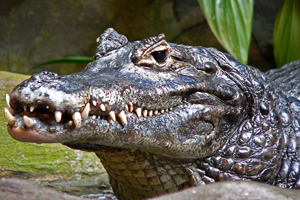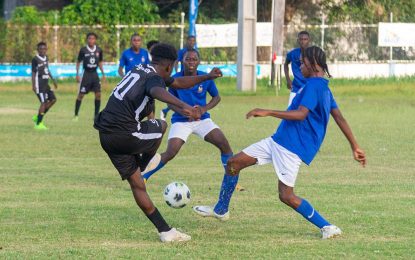Latest update November 20th, 2024 12:09 AM
Latest News
- Referendum on oil contract crucial before any future negations with Exxon-WPA
- Foreign companies making US millions in Guyana must pay fair share of taxes-says Jagdeo
- Risk of famine in Gaza has reached disaster levels’: Turkey’s President
- Woman raped and robbed in Linden
- Brutus on $16.25M bail for 231 financial crime charges
The Black caiman (Melanosuchus niger)
May 12, 2013 Features / Columnists, Interesting Creatures in Guyana
The black caiman (Melanosuchus niger) is a large crocodilian and the biggest extant member of the family, Alligatoridae. It is a carnivorous reptile that lives along slow-moving rivers, lakes, seasonally-flooded savannas of the Amazon basin, and in other freshwater habitats of South America. It is a quite large species, growing to sizes of at least 5 m (16 ft) and possibly up to 6 m (20 ft) in length.
As its name implies, the black caiman has a dark colouration, as an adult. In some individuals the dark colouration can appear almost black. However they have grey to brown banding on the lower jaw. Juveniles have a more vibrant coloration compared to adults with prominent white to pale yellow banding on the flanks that remains present well into adulthood, at least more when compared to other species. The morphology is quite different than other caimans but the bony ridge that occurs in other caimans is present. The head is large and heavy; an advantage in catching larger prey.
The black caiman is the largest predator in the Amazon ecosystem, preying on a variety of fish, reptiles, birds and mammals. They are generalists and an apex predator, potentially capable of taking any animal within its range, including other predators.
Few ecological studies have been carried out on the species but it can be noted that the black caiman has its own ecological niche that enables coexistence without too much competition. As the largest predator in the ecosystem, it may also be a keystone species, playing an important role of maintaining the structure of the ecosystem.
Reproduction takes place in the dry season. Females build a nest mound with an egg chamber, protecting the eggs from predators. Hatchlings form groups called pods, guarded by the presence of the female. These pods may contain individuals from other nests. Once common, it was hunted to near extinction primarily for its commercially valuable hide. It is now making a comeback, listed as Conservation Dependent.
But the black caiman is a dangerous species to humans and attacks have occurred in the past. It has dark-coloured, scaly skin. The skin coluration helps with camouflage during its nocturnal hunts, but may also help absorb heat. The lower jaw has grey banding (brown in older animals), and pale yellow or white bands are present across the flanks of the body, although these are much more prominent in juveniles. This banding fades only gradually as the animal matures. The bony ridge extending from above the eyes down the snout, as seen in other caiman, is present. The eyes are large, as befits its largely nocturnal activity, and brown in colour.
Mothers on guard near their nests are tormented by blood-sucking flies that gather around their vulnerable eyes leaving them bloodshot.
The black caiman is structurally dissimilar to other caiman species, particularly in the shape of the skull. Compared to other caimans, it has distinctly larger eyes. Although the snout is relatively narrow, the skull (given the species’ considerably larger size) is much larger overall than other caimans. The greatest length of the skull can range to over 62 cm (24 in).
Black caiman are relatively more robust than other crocodilians of comparable length. For example, a 3.9 m (13 ft) adult was found to have a considerably heavier and longer skull than a 4.8 m (16 ft) Nile crocodile (Crocodylus niloticus). Young black caiman can be distinguished from large spectacled caiman by their proportionately larger head and shorter tail, as well as by the colour of the jaw, which is light coloured in the Spectacled caiman and dark with three black spots in the black caiman.
Hatchlings eat crustaceans and insects but quickly graduate to eating fish, including piranhas, catfish, and perch, which remain the primary food source for all black caiman. Various prey will be taken by opportunity, including turtles, birds and mammals, the latter two mainly when they come to drink at the river banks. Larger specimens can virtually take any South American terrestrial or riparian vertebrate unfortunate enough to encounter them. Large prey can include deer, capybara, tapirs, anacondas, smaller species of caiman, giant otters, and domestic animals including pigs, cattle, horses and dogs. Where capybara herds are common, they are reportedly the most common prey item for mature adults.
Compared to the smaller caiman species, the black caiman more often hunts terrestrially at night, using its acute hearing and sight. As with all crocodilian species, their teeth are designed to grab but not chew, so they generally try to swallow their food whole after drowning it. Large preys that cannot be swallowed whole are often stored so the flesh will rot enough to allow the caiman to take bites out of the flesh.
At the end of the dry season, females build a nest, of soil and vegetation, which is about 1.5 metres (5 ft) across and 0.75 metres wide (2.5 ft). They lay up to 65 eggs (though usually somewhere between 30 and 60), which hatch in about six weeks, at the beginning of the wet season, when newly-flooded marshes provide ideal habitat for the juveniles once hatched.
The eggs are quite large, averaging 144 g (5.1 oz) in weight. Unguarded clutches (when the mother goes off to hunt) are readily devoured by a wide array of animals, regularly including mammals such as South American coatis (Nasua nasua) or large rodents, egg-predating snakes and birds such as herons and vultures. Occasionally predators are caught and killed by the mother caiman. Hatching is said to occur between 42 and 90 days after the eggs are laid.
It is well documented that, as with other crocodilians, caimans frequently move their young from the nest in their mouths after hatching and transport them to a safe pool. The mother will assist chirping, unhatched young to break out of the leathery eggs, by delicately breaking the eggs between her teeth. She will try to look after her young for several months but the baby caimans are largely independent and most do not survive to maturity.
Baby black caimans are subject to predation even more regularly after they hatch, facing many of the same mesopredators, as well any other crocodilian (including those of their own species), large snake or large, carnivorous fish that they encounter. Predation is so common that black caimans count on their young to survive via safety in numbers.
(Source: Wikipedia – The Free Online Encyclopedia)
Share this:
- Click to print (Opens in new window)
- Click to email a link to a friend (Opens in new window)
- Click to share on Facebook (Opens in new window)
- Click to share on WhatsApp (Opens in new window)
- Click to share on Twitter (Opens in new window)
- Click to share on Pinterest (Opens in new window)
- Click to share on Pocket (Opens in new window)
- Click to share on Tumblr (Opens in new window)
- Click to share on Reddit (Opens in new window)
- Click to share on LinkedIn (Opens in new window)
Related
Similar Articles

The Glenn Lall Show | November, 18th, 2024
Follow on Tik Tok @Glennlall
THE BLUNT OF THE DAY

Sports
Nov 19, 2024
Kaieteur Sports- The Ministry of Education ground came alive on Sunday as the Republic Bank Schools’ Under-18 Football League wrapped up its fifth round of competition with thrilling...Features/Columnists
CWI names West Indies Test Squad for home series against Bangladesh
West Indies Men’s Test players in a celebratory moment. (CWI) ST JOHN’S, Antigua- Cricket West Indies (CWI)... more
Rising Gun Crimes in the Caribbean: Urgent Action required by all
By Sir Ronald Sanders Kaieteur News – There is an alarming surge in gun-related violence, particularly among younger... more
Publisher’s Note
Freedom of speech is our core value at Kaieteur News. If the letter/e-mail you sent was not published, and you believe that its contents were not libellous, let us know, please contact us by phone or email.
Feel free to send us your comments and/or criticisms.
Contact: 624-6456; 225-8452; 225-8458; 225-8463; 225-8465; 225-8473 or 225-8491.
Or by Email: [email protected] / [email protected]
Weekend Cartoon














